FOREWORD This is no ordinary cook book.

FOREWORD This is no ordinary cook book.
This is a cook book full of excellent Polish recipes, collected through the years by a group of Polish American ladies. Anyone who has lived in Poland knows that Polish cooking is delicious. Its typical dishes are reminiscent of the best French and central European cooking. The famous soups, zakski (hors d'oeuvres) and pastries cannot be excelled anywhere. Every Polish woman has been taught the art of managing a household in the most economical way. Nothing is ever thrown away, and they have clever ways of using left-overs, such as making cordials of fruit skins, which are said to have medicinal qualities.
This training has stood Polish women in good stead, now that they have lost everything. They earn their living working in restaurants, making pastries at home, cooking for orphanages and hospitals. Many little restaurants have opened up in small temporary wooden shacks built amongst the bombed-out houses and there one can buy very good cooked hams, pastries and other delicacies. Looking back on years in Poland brings back many memories, not only of good food. These are bound to be poignant and saddened by the thought that such great changes have taken place. The houses in Warsaw we used to know are in ruins and most of the owners are scattered to the four corners of the earth, or dead.
Well do I remember the young Polish chef we employed in Warsaw, a man who could make anything from the most tasty roasts to delicate light-as-air pastry. Never, during the fifteen years I kept house and tasted the best food in many countries, have I seen such an artist in the culinary art. He had been beautifully trained in the best Cordon Bleu cooking school in Warsaw and as a proof that he was quite exceptional, when Anthony Biddle came as American Ambassador to Poland several years before the war and was looking for the best cook for the Embassy, whom should he get but our friend whom we employed some years before! Since the Biddies gave very fine parties in the handsome 18th century palace of Count Raczynski, as well as in the charming chateau Natolin they rented near Willanow twelve miles outside of Warsaw, our artist cook had an excellent opportunity to show off his skill. When I arrived in Minneapolis just before the last war, almost my first friends were these ladies of Polish descent who have compiled this book. We worked on Polish Relief together, and I find that they too have lived up to the warmhearted, traditional Polish hospitality and friendship. I accepted with sincere appreciation their invitation to write this foreword, both to pay my tribute to the Polish people and to recommend this book, for I know the reader will find many treasures among its recipes.
MARGARET B. HAWKS  INTRODUCTION To the Pole the holiest of cdl edibles is bread. His petition in his daily prayer has a special meaning for him, for so many times the Pole has had to do without it. Famine and wars have been a common occurrence in the Old World. Therefore a Pole never wastes his bread. He eats the dark, heavier breads for his every day fare.
INTRODUCTION To the Pole the holiest of cdl edibles is bread. His petition in his daily prayer has a special meaning for him, for so many times the Pole has had to do without it. Famine and wars have been a common occurrence in the Old World. Therefore a Pole never wastes his bread. He eats the dark, heavier breads for his every day fare.
His holiday baking calls for pikna pszenna m$ka, beautiful wheat flour. Every crumb of old bread is used for food. Polish cooking requires the use of bread crumbs for binding, thickening, lining of baking pans, and garnish. Vegetables Polonaise are served with a thick coatinq of buttered bread crumbs. The bread is dried completely and put through a grinder. The crumbs may be kept indefinitely in a clean brown paper bag.
They may be stored in a glass jar. The cover on the jar must be punctured to keep the crumbs from getting musty. Baking in Poland, delicious in its results, was a test of endurance and muscle. Old recipes say "Beat butter or eggs and sugar for one hour, and in one direction only." We have not changed any of the ingredients in the recipes, but we have changed the manipulation. We have tried to bring it up to date with no sacrifice of quality. A hand-driven egg beater of the modern type can do in thirty minutes what a spoon did in sixty.
And the electric-driven beater shortens the time to fifteen or twenty minutes and gives just as good results. For best baking results all ingredients should be at room temperature, all other theories notwithstanding. In short pastry, too, it is the chilling after the dough is made that makes it flaky rather than the use of hard fat and ice water in the mixing. All flour should be warm and sifted before measuring. To intensify the yellow color in coffee cakes and other pastries, add the salt to the egg yolks. All dough must be leavened.
Air is the chief leaven. Air is beaten into egg whites. Creaming fat and sugar incorporatessome air. into the mixture. Flour absorbs air when it is sifted. Air is beaten directly into the batter if it is of an elastic texture.
The other three leavening agents used to cause carbon dioxide in a dough are: yeast # baking soda and baking powder. Yeast, the oldest of them, is widely used in Poland. Soda was used to some extent long before the invention of baking powder and many old cookbooks and family recipes specify its use. Baking powder is slowly being introduced. The generous use of butter in the recipes may startle you. You may ask do they use so much butter in Polanda The answer is yes and let us tell you why.
In the rural areas, every household owns a cow and many own herds of prize cattle. European refrigeration leaves much to be desired. Of necessity the Polish farmer kills his livestock in the cold months when meat will keep. Shortening or lard rendered in the cold months will not stand the summer's heat. The vegetable shortenings that keep well in or out of the ice-box were unknown to Europe until they began to arrive in food packages after the war. The farmer's faithful cows give milk all year.
In almost no time at all, the farmer's wife can churn a jar of butter for her table and kitchen. Use your judgment in making substitution for butter but the flavor of it in foods is its own reward. When purchasing butter in paraffined cartons, always remember that each quarter-pound print of butter measures exactly one-half cup. When you want to measure one-fourth cup of butter, just cut one of the quarter-pound prints in half. This saves measuring in a cup. Thus time is saved and butter, too, for in most instances it is impossible to remove all of the butter from the measuring cup.
Eggs are used abundantly. They are counted up to ten. After that they are measured. A recipe may call for a liter or poi-kwaterek (half-pint) or kope (sixty) eggs. Often the farmer's wife earns enough money from the sale of eggs from her chickens to run the household. There always are enough left for her use.
Not all American cooks know how to use sour cream and sour milk to advantage. For centuries European countries have recognized the beneficial qualities of sour cream, buttermilk and sour milk. Lactic acid in these foods is the result of the action of certain bacteria on milk sugar or lactose. This healthful food is of the greatest hygienic and therapeutic value to the digestive tract and health in general. Sour cream gives additional zesj to soups, is the finest and most delicate marinating agent for meats, blends naturally with both garden and fruit salads, is delicious in desserts, and makes the tenderest of finetextured cakes, cookies and bread stuffs. Its use in Poland is that of a necessary staple.



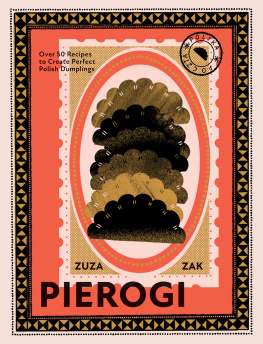
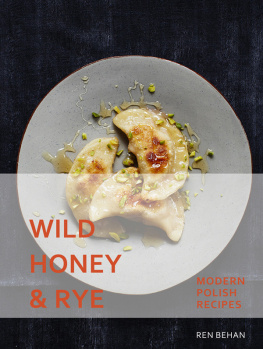

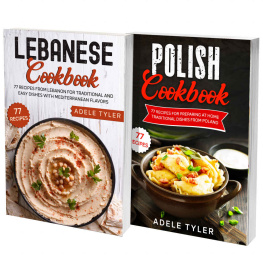
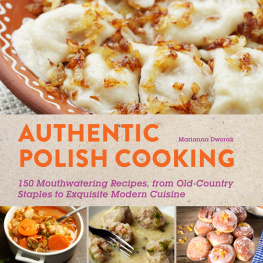
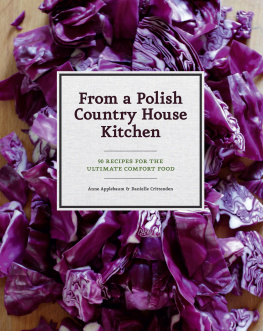
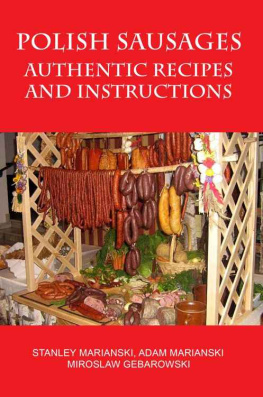

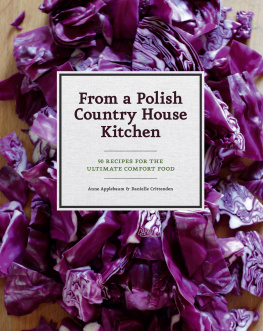
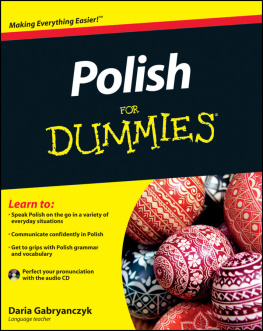
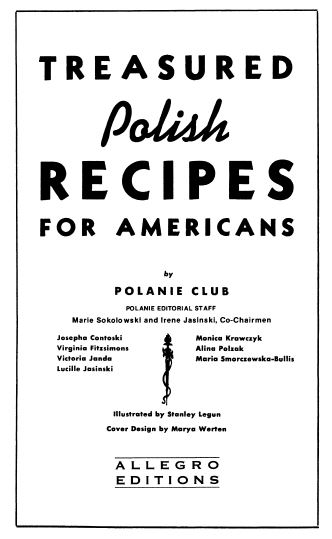 Copyright 1948 Polanie Publishing Company Published by Allegro Editions ISBN: 978-1-62654-949-4 Printed in the U. S. A.
Copyright 1948 Polanie Publishing Company Published by Allegro Editions ISBN: 978-1-62654-949-4 Printed in the U. S. A. FOREWORD This is no ordinary cook book.
FOREWORD This is no ordinary cook book.  INTRODUCTION To the Pole the holiest of cdl edibles is bread. His petition in his daily prayer has a special meaning for him, for so many times the Pole has had to do without it. Famine and wars have been a common occurrence in the Old World. Therefore a Pole never wastes his bread. He eats the dark, heavier breads for his every day fare.
INTRODUCTION To the Pole the holiest of cdl edibles is bread. His petition in his daily prayer has a special meaning for him, for so many times the Pole has had to do without it. Famine and wars have been a common occurrence in the Old World. Therefore a Pole never wastes his bread. He eats the dark, heavier breads for his every day fare.